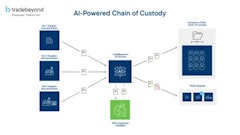The US is one of two major beef-exporting countries with no comprehensive traceability system," says Erin Borror, a US Meat Export Federation (USMEF) economist. "Going forward, it places the US at risk if an animal-disease outbreak occurs in this country, or if import customers impose traceability requirements."
According to a recent USMEF-commissioned study, India and the US are the only major beef-exporting nations without comprehensive traceability. Key US beef export competitors with comprehensive traceability systems include: Argentina, Australia, Brazil, Canada, New Zealand and Uruguay. Major importers of US beef that have comprehensive domestic traceability programs include the European Union, Japan and South Korea.
Sans comprehensive standardized livestock ID and traceability in the US, US beef exporters and their customers currently rely on carcass inspection through the Food Safety Inspection Service, as well as add-on programs such as the Beef Export Verification Program. The program is administered through USDA's Agricultural Marketing Service and allows exporters to meet Japan's beef-age requirement.
According to the USMEF study entitled "Economic Assessment of Evolving Red Meat Export Market Access Requirements for Traceability of Livestock and Meat," implementing a comprehensive cattle ID and traceability system in the US could cost a pittance compared to the revenue lost if export customers make it a condition of trade. The study was conducted by researchers at Colorado State University, Kansas State University (KSU) and Montana State University.
In addition to examining the potential cost of lost exports if major customers imposed additional traceability requirements as a condition of trade, the study also quantified the increased exports required to pay for additional traceability. For economic modeling, they considered the potential of an age- and source-verification program as a potential requirement to maintain export access to specific markets.
For beef, researchers say losing export access to South Korea, for example, would cost 7.3 percent of total US beef exports, or about $1.8 billion over 10 years. The net loss to society would be more than twice what US consumers would gain through more beef being available in the domestic market at lower prices.
On the other side of the equation, researchers estimate gaining access to a major export market would pay for the source and age verification assumed in the model.
"For instance, to offset the costs of expanding cattle traceability programs that would encompass a participation rate of 20 percent, a 1 percent increase in beef exports (19.5 million lbs.) would be required," say researchers. For perspective, the US exported 140 million lbs. to South Korea in 2009.
Glynn Tonsor, a KSU agricultural economist and one of the study's researchers, stresses tonnage and prices from 2009 were modeled. Since then, the increased value of beef exports to a given country would be higher and the cost of paying for a system could be offset by a smaller proportion of current exports.
"It's not just what the US does, but what the US does relative to other countries," Tonsor says. "The option of doing nothing costs more as the value of exports increase.
"The additional cost of expanding source and age verification participation by cattle producers is not zero, and adoption costs are higher for smaller operations," Tonsor says. "In aggregate, though, the study shows that the beef industry could feasibly expand or maintain existing exports through additional traceability at a low cost relative to the value of these exports."
The US is the world's largest beef producer and beef exporter. According to Borror, the US was exporting 13 percent of its fed-cattle beef production (muscle cuts) through October, the most in US history. That's 1 percent more than 2003, when beef exports had reached their zenith before most markets were shuttered to the US on account of BSE.
Throw in offal and variety meats, and Borror says the US was exporting 16.7 percent of fed-cattle beef production through October, also the most in US history. She notes the relatively weak US dollar and globally tight beef supplies helped increase export demand for US beef.
By way of reference, Borror says Brazil exports 16 percent-18 percent of its beef production, Canada exports 38 percent-40 percent and Australia exports 65 percent.
Though various nations continue talking about increased traceability requirements, none have yet imposed them. However, Borror explains Canada has made more inroads to trade with Hong Kong because of its traceability system. Traceability is also part of the current discussion between China and the US regarding beef exports. So, the competition can use traceability to its advantage even if a country doesn't require it.
For that matter, Tonsor points out that some private companies can and do impose requirements that are more stringent than a nation's import requirements.
Although market access and producer profitability have been important factors in exporting countries' decisions to establish traceability systems, the study concludes that animal health management and food safety are the primary drivers behind most countries' decisions to incorporate animal ID and traceability into regulations for their livestock industries. Improved supply chain coordination and enhanced producer management opportunities are secondary motivators.
Keep in mind, neither USMEF nor the study's researchers are beating the drum for or against policies to create increased traceability. Instead, the study was conducted to assess the implications of traceability in the international marketplace.
"My hope is that this study will lead producers to think more deeply about the role of exports in US beef production, what it takes to maintain current levels and what might drive change," Tonsor says. "Traceability is just one factor that drives exports."
Leann Saunders, president of IMI Global, a member of USMEF's executive committee and chairperson of the USMEF working group on traceability, summed up the value of the study this way.
"When you first consider the value of the export market to US cattle and hog producers, with export value this July equating to $236.88/head of fed cattle harvested and $59.35/head for hogs, there is no denying the importance of exports for US producers," Saunders says.
"As we've seen in the beef industry engaged in voluntary USDA Process Verification Programs (PVP) and Quality System Assessment (QSA) verification programs for countries like Japan and the EU – countries that have export verification requirements specific to animal identification and traceability – it can work effectively. Since we're currently exporting about 16 percent of total US beef and variety-meat production, and 29 percent of pork, traceability is a form of insurance that would insulate American producers in the event that importing countries change their import requirements or in the event of an animal disease outbreak," she says.
The USMEF study can be found at http://bit.ly/uxDtDE.
Source: Insurancenewsnet.com


























